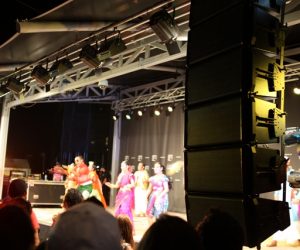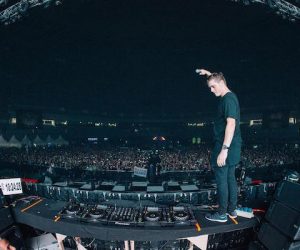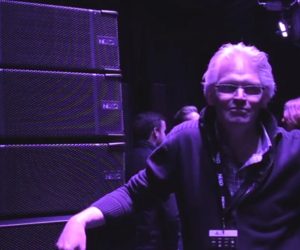
Nexo STM: Out with Jessica Mauboy
Monitor City’s STM rig gets a good nationwide hit-out with Darwin’s pop/R&B darling, Ms Mauboy.
I know, it’s almost impossible to avoid vehicle metaphors when talking about PAs, so why fight it? Consider the Nexo STM as somewhat like a tricked up, finely tuned street car — say a Subaru WRX. Much like a WRX you can drive it to work, you can bomb up the Hume Highway, you can leave it with valet parking at a fancy hotel, you can take the kids to school in it… it’s a sexy, versatile daily drive. Crucially, if you need to win a race, you’ve more than likely got the measure of just about anything else on the road. Does your STM ‘WRX’ have superior performance to a V10 Dodge Viper? Depends on what measure, but who’s gonna leave a Viper in the Coles carpark? Will the STM WRX go toe-to-toe with Mark Webber’s F1 car? Not in a straight line, but depends on where you put it. One thing’s for sure, you’re not going to order drive-through in the Red Bull car.
“The great thing about this system is its versatility — you’re not locked into any one configuration. At Newcastle Entertainment Centre we flew some of the elements in its double configuration [1 x Main module and 1 x Bass module flown side by side] with the S118 subs up top, and then we split one of the four-deep stacks and ground-stacked them left and right as single arrays for outfill. As it happened, on that show they opened up a bunch of seats we hadn’t planned for, and didn’t necessarily have the PA for. In other words, with an upper level now open, the outfill was asked to do a fair bit more than we initially envisaged. Regardless, it was too late to make any drastic changes, we just changed the angles on the outfill and it stood up well — we were able to cover the extra space more than adequately, despite it being a stretch. I can’t see how we would have pulled that off as elegantly with another system.”
That was FOH engineer Chris Braun, who’s out with Jessica Mauboy. It’s one of the first full-blown Australian tours using STM and we thought we’d tag along. Jessica Mauboy kicked off her tour in Adelaide mid November, and is covering every capital city and major regional centre over two months. It’s Monitor City’s STM rig, and Mark Bollenberger is taking care of the system design.



GETTING ACROSS STM
AT first caught up with the tour on the second date in Melbourne at the Plenary Theatre (MCEC). For that gig (addressing the centre section of the Plenary) Mark hung STM six deep with a pair of the new S118 subs up top. A further eight S118 were ground stacked, spaced across the front of the stage.
That’s about as conventional as the rig would get. AT caught up with Chris Braun deep into the regional Queensland leg to hear how else STM was being deployed.
Chris Braun: We’ve just come from Bundaberg Entertainment Centre where we ground stacked the STM, four aside, with six of the S118s across the front over three amp channels. We electronically steered the LF in and it was absolutely monstrous. These are the first S118s we’ve seen touring in Australia so we’re playing with what they’re truly capable of — from a system design point of view as well as what I can do from the mixing console. For example, I put some 30Hz into the PA last night and the subs took it without blinking, remaining punchy and tight, without getting loose. Stunning.
“Mixing on STM is fun. One aspect I love is there isn’t some kind of sweetspot where you have to push the PA for it to perform optimally. We run our STM anywhere from 93dBA in certain rooms through to 101dBA in others to achieve the same kind of intensity. But the results coming out of the PA don’t change and given our audience range is around 5 to 65, it’s perfect to be able to run the PA a couple dB quieter than normal for some of these rooms but still have the PA voicing.
“It’s an extremely clean PA — pristine even. More recently I’ve started playing with the Waves NLS channel and bus summing mixer. I’ve got the NLS Channel on all my group outputs. Everything on the mixer is grouped to a bus output with NLS over it, then I’ve got NLS Bus over the master L/R output [read more about NLS in the box item]. What amazed me was how easily I could hear the differences between the three NLS modes. This PA doesn’t hide anything. Of course, the flipside of that is if you make a mistake, the PA will tell you — if haven’t got a gate set just correctly, for example, you’ll hear it.”

VOCALS RIDING HIGH
AT: One thing I noticed at the Melbourne gig was the PA’s vocal clarity.
Chris Braun: It’s my job to help Jess manage her vocal and not burn her out. Jess is working her arse off on this tour. She’s dancing and singing, doing back-to-back gigs, with the occasion press event in the morning where she’ll sing a 45-minute set on show day after a show the previous night. That’s a massive ask.
Jess has an amazing voice with enormous volume, but I noticed after a few weeks that as the signs of fatigue began to show, she would overcompensate. So I had a chat to her about needing to pace herself and how I’d look after her vocal from the mixing console. I use Waves Max Volume II to help squeeze a little more out of her vocal towards the end of the night. So despite a little bit of fatigue creeping in, her vocal is still sitting right over the top of the mix.
I’m using a Shure UHFR wireless setup with the KSM9 capsule. The KSM is working well. Jess’s vocal is loud and the capsule handles it well and the mic’s response seems to complement her voice well — there’s an airy 10-12k on her vocal that suits, especially in the quieter more acoustic parts of the set.
The only other vocal mic on stage is an Audio-Technica AE6100 — a hypercardioid dynamic. It’s been my go-to wired vocal mic for a few years ago — I’ve stopped searching… for now.


STM SOUND
The sound of the Nexo STM couldn’t be mistaken for another PA. Just how you describe the sound is a more difficult. While talking to Chris Braun — who’s had plenty of experience mixing on a whole variety of PAs, particularly with L-Acoustics V-DOSC and d&b J, we mused on how everything in the signal path — the wireless, the desk, the Nexo 4×4 amps — is getting cleaner and more efficient. So perhaps one way of explaining the sound of STM is to say, there is no sound — simply a louder representation of what you’re feeding it.
Chris Braun: “[Monitor City’s] Ade came up to me laughing after the Melbourne gig. Apparently he was watching the power meters during the encore — when my level goes up a couple of dB, and we’re pulling the most juice — and he reckoned audio was pulling only 12A per phase tops! Which is absolutely nothing. The efficiency of this gear compared to, say, when V-DOSC was first released 20-odd years ago, is just incredible.
AT: But is the PA choice now a matter of ‘horses for courses’, rather than there being a winner?
CB: V-DOSC, J-Series, Adamson, they’ve all got their own tone, in the same way that Genelec, ADAM and Dynaudio have their own characteristics in studio land. Some people get stuck: ‘I’m only ever going to use this PA’. Well, great, great but one PA may not work as well for a band as the next so i think there is still a decision that needs to be made on matching the PA to the band and the type of tour you’re doing, be it an arena tour, a theatre tour or anything in-between. PA’s are becoming more and transparent though, with the introduction of the Meyer Leo and now the STM and K1, you really are just getting a much closer picture of what you put in, you get out, it’s really cool. if you’re at that level in the game where you can afford to say, ‘I’m only taking Milo, or I’m only using DOSC’… great. The other side of the coin is, maybe that PA doesn’t work best for that band in the type of venue you’re gigging in.
AT: Where does STM fit it in?
CB: We were only just looking at some pics of one of the big Country artists in the US using STM 24 deep with 24 subs aside. Nuts. Would love to hear that in action. We’ve been getting great results with six or eight deep with 12 S118 subs. Great results in arenas — the volume, coverage, tone… it’s all staggering. STM is a different beast to a lot of it’s competitors because of it’s scalability. One night, you can be running three wide and pinning people to the back wall (if that’s your thing) in an arena while the next night you could be doing a single stack per side in a much smaller venue with just an acoustic guitar, it all depends on what you choose to deploy and how.
It helps to have someone of Mark’s calibre, who’s mapped the rooms prior and system tech’ing. And again, I’m constantly being amazed with how versatile this rig is and the results that Mark is able to achieve with what we have with us. One night in Bundaberg we had the system ground stacked and during the support act everyone got out of their seats and, as a result, all the high end disappeared. Mark and I just looked at each other and without saying a word it was like: ‘okay, so this is how it’s going to be’. But what do we do? He pulled out his laptop while I kept mixing the support act (where I was effectively doing a sitdown mix and a stand-up mix depending on the song). Anyway, he put a new room model in, changed a couple of angles, hit ‘Create’, and it spat out a new coverage pattern. He showed it to me; we agreed on it; then, literally, during the support set, changed the angle on the boxes (we were ground stacked, so it was possible). The difference in splay angles? Half a degree. But as soon as he moved it, the top end went ‘hello, here I am’. It’s a testament to Mark and the rig and what it can achieve: one man; click, click, click [with the rigging] done. Try doing that with another PA: Let’s do it during changeover. Let’s get a couple of guys. You hold that. Don’t jam my finger!
AUDIO CREW LIST
FOH: Chris Braun
System Tech: Mark ‘The Dr’ Bollenberg
Production Manager: Ade Barnard
Monitor Engineer: Ivan Ordenes
Monitor Rigger: Gina Hanlon
Guitar Tech: Pat Meyer
Drum/Keys Tech: Christian Walsh
















RESPONSES